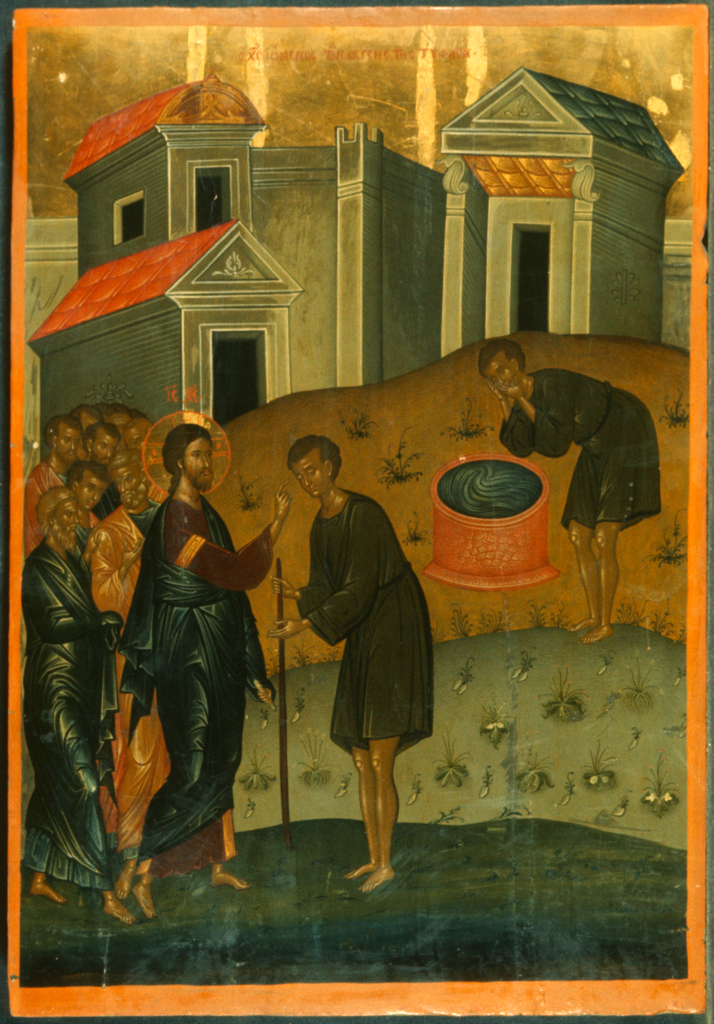Click here to watch a video of this service on our YouTube channel. (Live stream will be at 7pm on May 19th, 2020)
First & Third Hour for Tuesday of the Week of the Man Born Blind
Click here to watch a video of this service on YouTube (live stream begins at 9am, Tuesday, May 19th, 2020)
The Mystery of Evil
Why do we suffer? Why is there a pandemic? Why do bad things happen to good people? Why is it that babies sometimes die before they get a chance to live? Why is it that sometimes they are born blind, like the man in today’s Gospel?
Theologians know that God does not make death – that no evil comes from God – that God is the author of every good and only good. In other words, theologians know that God is not to blame for our suffering or for death or for blindness.
Whence come these things into the world, then? Well, the wages of sin is death, as St. Paul reveals (Rom 6:23). So, it would seem that sin, which is missing the mark, is somehow the origin of every injustice. Every instance of a good person suffering evil may be rightly blamed on sin – either on their own sin or on someone else’s sin.
It’s clear that it’s not always our own sin that causes us to suffer, though it often is. But if someone persecutes or abuses you, you suffer even though you have done nothing wrong. Everything that Jesus suffers is like this. Jesus is altogether sinless. Yet, he suffers greatly from the sins of others who persecute him and mock him and torture him and crucify him. When we suffer at the hands of others, we do well to remember that Jesus has identified with us in that – and has taught us also how to respond to it – with forgiveness.
Nonetheless, people usually do not respond that way to the injustices they suffer. Most people, when they get hurt, lash out and hurt others – often the ones they hurt aren’t even the same people that did them harm. Sometimes, for example, a boss will humiliate someone at work and, too fearful and cowardly to respond like a Christian to the one who has wronged him – with courage and honesty – and without animosity or resentment, instead they swallow the humiliation and shame and anger and resentment and bring that home to their spouse and their children – snapping at them and humiliating them, though they’re totally innocent and only want love and kindness.
Sometimes, we’re not even good at revenge. Revenge is a bad thing but taking it out on the innocent is even worse. Yet many times this is what we do.
In this way, our sin sends out ripples of hurt harm into the world. That’s clear. When one person gets hurt, it often leads to them hurting others. Hurt people hurt people. That’s not a justification, by the way. There is no justification for us to hurt each other – to be nasty to one another, or unforgiving, or judgmental. It’s not a justification, it’s just an observation. This can all be easily observed in our own lives.
Partly extrapolating from these experiences, some theologians have concluded that all suffering ultimately results from sin. There are the obvious ways in which this is the case, such as the examples I have described, but there are also hidden ways in which our sins hurt other people and ourselves.
We are spirits as well as bodies and so our sins have spiritual ramifications in the spiritual world as well as physical ramifications in the physical world. Sin is a break with our true created nature, which is both spiritual and material. We cannot even begin to imagine how much suffering each of our sins, voluntary and involuntary, brings into the world – into the whole cosmos. With our sin, which is unnatural, we disrupt the whole created order of nature.
So if we understand that sin is the cause of all human suffering, the disciples’ question to Jesus about the man blind since birth seems to be a reasonable one: “Who sinned, this man or his parents, that he was born blind?” (John 9:2). You see, they understood that blindness results from sin. That’s true. It’s true of both physical blindness and spiritual blindness. And they understood that we suffer from one another’s sins as well as from our own. In Exodus, the Lord says he will visit “the iniquity of the fathers upon the children” (Ex 20:5; 34:7). So they suggested that it might be the sins of his parents rather than his own sins that resulted in his blindness. Again, it’s not unreasonable, especially if we understand that this man’s parents include not only his mother and his father but even all his ancestors back to his first parents Adam and Eve. Surely the world is broken and sometimes people are born blind into this broken world because of sin.
We might also add the sins of demons to our consideration. Their sins too – and not only the sins of us humans – yield great suffering in the cosmos. They too are at war with God and with their own created nature.
In any case, despite all of this, Jesus once again confounds conventional theology. He says, “It was not that this man sinned, or his parents, but that the works of God might be made manifest in him” (John 9:3). Jesus later says the same thing about the illness of Lazarus, saying that “it is for God’s glory so that God’s Son may be glorified through it” (John 11:4).
I am left gasping at this explanation which confounds all my reason. I could dance around it with cleverness and point out that Jesus does not altogether deny the role of sin in the origin of blindness. He only says that it wasn’t the sins of this man or his parents. One could argue that perhaps the sins of others or the sins of demons are to blame. But Jesus doesn’t blame any sin at all in his etiology of the blindness. My reason wants to chirp, “If sin is not to blame, then what? If no sinner is at fault, then who? God?” I cannot blame God for this man’s blindness. But Jesus says that he is blind so that the works of God might be made manifest in him.
I understand very well that Jesus heals him – and that this is a work of God that reveals the divinity of Jesus. I understand very well that the Lord uses the man’s blindness to teach the world to see. This is what the Lord does again and again. Out of the darkness, he brings light – as on the first day of creation. He says, “Let there be light.” And there is light. I see that, out of death, the Lord brings life. By death, he tramples death. And so, how fitting that through the blindness of one man, he gives eyes of faith to many. The man whose eyes are opened is brought before those who deny that Jesus is from God and he testifies to the healing, and that Jesus is of God, and he believes and worships Jesus (John 9:11, 13, 16, 25, 30-33, 38).

The Sinai Icon Collection
The Lord brings good out of evil. That’s what the Lord does. But he is the origin of no evil. So today, when he says that the man is blind so that God can heal him, I don’t understand. That’s a mystery to me. It’s rather like the mystery of the cross.
I want to ask Jesus after he gives his explanation, “Yeah, but, had it not been for sin in the world, surely this man would not have been born blind?” But that’s not the kind of question we’re going to hear from Jesus or his disciples. That’s the kind of speculative theology they don’t get into. Maybe that kind of thinking is more Greek than Hebrew – or maybe it’s more a curse of this age than that to be vexed by such questions. You won’t hear them saying things like, “Well, if reality were other than it is, what then would this or that be?” That’s not their shtick – not at all. Jesus is much more interested in healing this man than in theoretically analyzing his condition.
We ought to be like Jesus in this. Simply love, show compassion, heal, deliver, all to the glory of God, rather than trying to subject everything to our finite analytical human understanding, as if reality, or even God, were subject to us. If, instead, we seek to glorify God, then God blesses us beyond all understanding.
The mystery of good and evil is beyond our comprehension. And there comes a time to accept that we cannot understand everything – and that every answer we can give is a lie. The Truth is a Person, not an answer. Perhaps we can understand best in silent contemplation of the awesome mystery when we stop trying to figure everything out and abandon ourselves completely to God.
Divine Liturgy for the Sunday of the Man Born Blind
Click here to watch a video of this service on our YouTube channel. (Live stream will begin at 10am on Sunday, May 17th, 2020).
Matins for the Sunday of the Man Born Blind
Click here to watch this on YouTube (live stream is at 8am on Sunday, May 17th, 2020)
Matins Propers Sunday of the Man Born Blind (abbreviated)
- « Previous Page
- 1
- …
- 153
- 154
- 155
- 156
- 157
- …
- 189
- Next Page »
